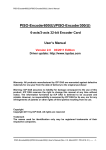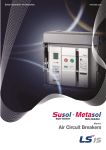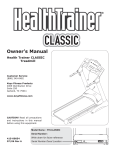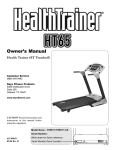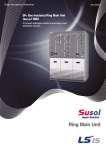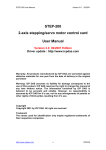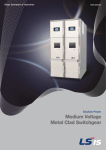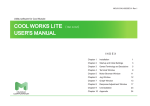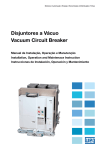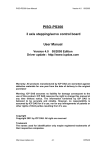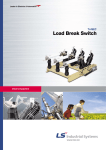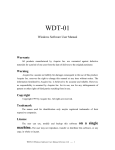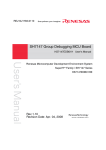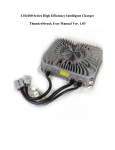Download User`s Manual - ICP DAS USA`s I
Transcript
PISO-Encoder600/PISO-Encoder300 User’s Manual PISO-Encoder600/PISO-Encoder300 6-axis/3axis 32-bit Encoder Card User’s Manual Version 1.0 04/2005 Edition Driver update: http://www.icpdas.com Warranty: All products manufactured by ICP DAS are warranted against defective materials for one year from the date of delivery to the original purchaser Warning: ICP DAS assumes no liability for damage consequent to the use of this product. ICP DAS reserves the right to change this manual at any time without notice. The information furnished by ICP DAS is believed to be accurate and reliable. However, no responsibility is assumed by ICP DAS for its use, nor for any infringements of patents or other rights of third parties resulting from its use. Copyright Copyright 2002 by ICP DAS. All rights are reserved Trademark The names used for identification only may be registered trademarks of their respective companies. PISO-Encoder600/ PISO-Encoder300 User’s Manual (Rev. 1.1, April/2005 PPH-018-10 ) ----- -1- PISO-Encoder600/PISO-Encoder300 User’s Manual Contents of PISO-Encoder600/PISO-Encoder300 Encoder Card 1 General information ...............................................................................................................................3 1.1 Introduction......................................................................................................................................3 1.2 Key Features ....................................................................................................................................3 1.3 System Block Diagram ....................................................................................................................3 2 Hardware ...............................................................................................................................................5 2.1 Hardware address selection .............................................................................................................5 2.2 Registers of the PISO-Encoder600/PISO-Encoder300 board .........................................................7 2.2.1 Control register .........................................................................................................................7 2.2.2 Counter value register .............................................................................................................9 2.2.3 Digital output register............................................................................................................10 2.2.4 Digital input register...............................................................................................................11 2.3 Program guide................................................................................................................................11 2.3.1 Initializing the control register ...............................................................................................12 2.3.2 Reading the X1-axis 32-bits encoder counter value ..............................................................12 2.4 Connection .....................................................................................................................................14 2.4.1 Pins assignment .....................................................................................................................14 2.4.3 The internal circuit of encoder interface ...............................................................................17 2.4.3 Internal circuit of digital inputs HR1~HR6 ..........................................................................18 2.4.4 Internal circuit of digital outputs DO1~DO8 ........................................................................18 2.4.5 The connection of encoder ....................................................................................................19 3. Software ..............................................................................................................................................20 3.1 Functions........................................................................................................................................20 3.1.1 Loading and unloading driver commands (only for windows)..............................................21 3.2.2 Commands ..............................................................................................................................21 4. Driver ..................................................................................................................................................25 4.1 DOS Driver (C, C++) ....................................................................................................................25 4.2 Windows 95/98 Driver ..................................................................................................................25 4.3 Windows NT Driver ......................................................................................................................25 5. Example................................................................................................................................................27 5.1 Dos examples.................................................................................................................................27 5.2 Windows installation .....................................................................................................................28 5.3 Windows examples ........................................................................................................................29 PISO-Encoder600/ PISO-Encoder300 User’s Manual (Rev. 1.1, April/2005 PPH-018-10 ) ----- -2- PISO-Encoder600/PISO-Encoder300 User’s Manual 1 General information ________________________________ 1.1 Introduction The PISO-Encoder600/PISO-Encoder300 is a high performance and high speed 6– axis/3-axis 32-bit PCI bus Encoder Card for the IBM compatible PC. The high-end specifications of this encoder card and complete software support make it ideal for wide range applications in position measurement of motion systems for industrial and laboratory environment. The key features are described as below. 1.2 Key Features 6-axis Encoder counter True 32 bits counter PCI bus Maximum counting rate: 1MHz. 3rd-order internal digital filter. Counting mode: Quadrant, CW_CCW, PULSE_DIR A+, A-, B+, B-, C+, C- inputs. Programmable reset counter function. Index (C channel) reset counter function. Hardware reset (HR1~HR6), reset counter function SCSI-II 68-pin connector. 8 digital outputs (DO1~DO8), 6 digital inputs (HR1~HR6). 2500V optical isolation. DOS, Windows 95/98, Windows NT/2000 drivers. BCB, VB and Delphi demos (with source code). PISO-Encoder300 only has 3-axis (x1,x2,x3), 3-index (c1,c2,c3), and 3 hardware Reset (HR1,HR2,HR3) Optional daughter board An optional DN-68 SCSI-II (68 Pins) daughter board comes with connection Cable. It provides easy installation with PISO-Encoder600 and hardware system. 1.3 System Block Diagram The PISO-Encoder600 has a 6-axis encoder counter. And each axis has a 32-bit true counter with maximum counting rate of 1MHz. It also offers three different types of PISO-Encoder600/ PISO-Encoder300 User’s Manual (Rev. 1.1, April/2005 PPH-018-10 ) ----- -3- PISO-Encoder600/PISO-Encoder300 User’s Manual the counting mode, which are QUADRANT mode, CW_CCW mode, and PULSE_DIR mode. User should choose the correct mode based on actual type of encoder. Otherwise, the PISO-Encoder600 will not work properly. Besides, PISO-Encoder600 also provides 3 different functions of counter resetting mode including register reset, index reset and hardware reset. The Index reset function is used to reset encoder counter through using a C+/C- channel signal during every revolution. The hardware reset function is adopted to reset encoder counter by a pre-defined external signal pin, namely HR1~HR6. Furthermore, when PISO-Encoder600 is not set on the hardware reset mode, the pins of HR1~HR6 can be open as digital inputs. In addition, PISOEncoder600 also offers 8 channels of digital output. Every digital output and input (digital I/O) is photo-coupled isolated up to 2500Vrms. The detailed function block diagram of PISO-Encoder600 is demonstrated and summarized in the following figure. X1,X2,X3 SCSI-II connector digital input digital output 2500Vrms photocoupled isolation 32-bit encoder counter X4,X5,X6 32-bit encoder counter PCI bridge Figure 1: block diagram of PISO-Encoder600 PISO-Encoder600/ PISO-Encoder300 User’s Manual (Rev. 1.1, April/2005 PPH-018-10 ) ----- -4- PISO-Encoder600/PISO-Encoder300 User’s Manual 2 Hardware _ ____ 2.1 Hardware address selection The hardware address of PISO-Encoder600 board can be set as 0~15 by DIP switch A0~A3 on the PISO-Encoder600 board, as shown in Figure 2. The factory hardware address setting is Hex 00. If the default address of this card is used by other device, user can change the setting to various base addresses. The addressing of PCI bus is defined in Table 1. According to the hardware address setting, programmer should call function ENC6_REGISTRATION(cardNo, address) to confirm with the hardware setting in the beginning of the program. The more detailed description for function of ENC6_REGISTRATION() will be presented in chapter 3. 0x00 = A0 A1 A2 A3 0x0F = A0 A1 A2 A3 Figure 2 Hardware address selection Table 1: Hardware address setting PCI Address A0 A1 A2 0* 0 0 0 1 1 0 0 2 0 1 0 3 1 1 0 4 0 0 1 5 1 0 1 6 0 1 1 7 1 1 1 8 0 0 0 9 1 0 0 10 0 1 0 11 1 1 0 12 0 0 1 13 1 0 1 14 0 1 1 15 1 1 1 A3 0 0 0 0 0 0 0 0 1 1 1 1 1 1 1 1 PISO-Encoder600/ PISO-Encoder300 User’s Manual (Rev. 1.1, April/2005 PPH-018-10 ) ----- -5- PISO-Encoder600/PISO-Encoder300 User’s Manual Note: On=0, OFF=1 ,* factory setting PISO-Encoder600/ PISO-Encoder300 User’s Manual (Rev. 1.1, April/2005 PPH-018-10 ) ----- -6- PISO-Encoder600/PISO-Encoder300 User’s Manual 2.2 Registers of the PISO-Encoder600/PISO-Encoder300 board The information of hardware registers is the most important issue in programming the PISO-Encoder600. Users should understand the meaning of every register in order to improve their program skill to communicate with the hardware system and to get and send information back and forth. A summary map of the address and data format of each register is explained in the following sections. It should be noted that the addresses of those registers are designated to the PCI base address. 2.2.1 Control register The following table shows the relative address of each register for encoder input channels 1~6. All control registers own the same data format but with different address locations. User can set the control register by PCI base address, for example, PCIBase+C0h. In the following description, X1-axis control register will be used to reveal the detailed setting functions for every axis encoder channel of PISO-Encoder600. WR1 X1-axis control register Address Type C0h W MSB 7 6 CRST HRRST 5 4 3 2 1 0 LSB B1 B0 /INH /RST S1 S0 5 4 3 2 1 0 LSB B1 B0 /INH /RST S1 S0 5 4 3 2 1 0 LSB B1 B0 /INH /RST S1 S0 WR2 X2-axis control register Address Type C8h W MSB 7 6 CRST HRRST WR3 X3-axis control register Address Type D0h W MSB 7 6 CRST HRRST WR4 X4-axis control register ( PISO-Encoder600 only ) Address Type D8h W MSB 7 6 CRST HRRST 5 4 3 2 1 0 LSB B1 B0 /INH /RST S1 S0 WR5 X5-axis control register ( PISO-Encoder600 only ) Address Type E0h W MSB 7 6 CRST HRRST 5 4 3 2 1 0 LSB B1 B0 /INH /RST S1 S0 WR6 X6-axis control register ( PISO- Encoder600 only ) Address Type E8h W MSB 7 6 CRST HRRST 5 4 3 2 1 0 LSB B1 B0 /INH /RST S1 S0 Note: The above addresses are based on the PCI base address. (ex. PCIBase+C0h.) For the X1-axis control register(WR1), the function of individual register bit is described as follows: PISO-Encoder600/ PISO-Encoder300 User’s Manual (Rev. 1.1, April/2005 PPH-018-10 ) ----- -7- PISO-Encoder600/PISO-Encoder300 User’s Manual Bits 1,0 (S1,S0): the counting mode selection of encoder input. 00 : quadrant-counting mode A B counter 1 2 3 4 5 6 Quadrant Counting Mode 01 : CW/CCW counting mode CW CCW counter 1 2 3 2 1 CW/CCW Counting Mode X2=0 10 : Pulse/Direction counting mode Pulse Direction counter X2=0 1 2 3 2 1 Pulse/Direction Counting Mode Bit 2 (/RST): Software counter reset. It provides software reset method of encoder counter. /RST=0 enable encoder counter reset. /RST=1 disable encoder counter reset. Bit 3 (/INH): inhibit counter value latch. /INH=0 inhibit counter latch. This bit should be set to 0 before reading out the counter value. /INH=1 enable counter latch. Every time, when data has been read out from the counter, this bit should be set to 1 for latching next counter data. Bits 5,4 (B1,B0): byte selection of 32-bit counter value. The data of 32-bit PISO-Encoder600/ PISO-Encoder300 User’s Manual (Rev. 1.1, April/2005 PPH-018-10 ) ----- -8- PISO-Encoder600/PISO-Encoder300 User’s Manual counter value is stored in 4 bytes. Only one byte data can be read out for each time. Therefore, B1 and B0 of control register are designated to select which byte will be chosen. 00: byte 0 01: byte 1 10: byte 2 11: byte 3 Bit 6 (HRRST): Disable/Enable hardware reset. HRRST=1 enable hardware input to reset encoder counter. That is, when HRRST=1 and HRn is connected to EXT_GND, encoder counter n will be reset to 0, where n indicates the encoder number (n = 1, 2, … 6). HRRST=0 disable hardware reset of counter value. Bit 7 (CRST): Disable/Enable encoder index reset (C+/C-). CRST=1 enable counter reset function by encoder index signal. That is, encoder counter value will be reset to 0 by encoder index (C+/C-) signal during every revolution. CRST=0 disable the function of encoder index reset. From the above description, the control register of PISO-Encoder600 board provides three types of counter value resetting mode, which are software reset, hardware reset and encoder index reset. User should carefully choose proper reset method according to software and hardware environment. Otherwise, encoder counter will be reset by the first coming resetting signal. 2.2.2 Counter value register Counter value registers are read-type registers, which is based on PCI address (Ex: PCIBase+C0h for X1-axis counter value, …), described in the table shown below. These registers are used to read out the encoder counter value. The reading procedure of encoder counter value is described as follows: (1) Before reading the counter value, the /INH of control register should be set to 0 to inhibit data latch. (2) The B1,B0 of control register should be set as 0~3 to assign which byte will be read out. The counter value of 32-bit encoder has four-byte data. Note that only one byte can be read out every time. PISO-Encoder600/ PISO-Encoder300 User’s Manual (Rev. 1.1, April/2005 PPH-018-10 ) ----- -9- PISO-Encoder600/PISO-Encoder300 User’s Manual (3) Send a request to read one byte data from counter value register, as shown in the following table. The address is according to which axis encoder is applied. (4) Repeat steps (2)~(3) to acquire four bytes of counter value. (5) After reading out the counter value, the /INH of control register should be set to 1 for next data latch function. RD1 X1-axis counter value register address Type C0h R RD2 Type C8h R Type D0h R Type D8h R 3 2 1 0 LSB 2 1 0 LSB 2 1 0 LSB 2 1 0 LSB 2 1 0 LSB 2 1 0 LSB counter value MSB 7 6 5 4 3 counter value MSB 7 6 5 4 3 Counter value MSB 7 6 5 4 3 counter value X5-axis counter value register ( PISO-Encoder600 only ) address Type E0h R RD6 4 X4-axis counter value register ( PISO-Encoder600 only ) address RD5 5 X3-axis counter value register address RD4 6 X2-axis counter value register address RD3 MSB 7 MSB 7 6 5 4 3 counter value X6-axis counter value register ( PISO-Encoder600 only ) address Type E8h R MSB 7 6 5 4 3 counter value 2.2.3 Digital output register PISO-Encoder600 offers 8 digital output channels. Digital output register is writetype register, locating at the address of PCIBase+C4h, to send out information through digital output channels. The data format of the digital output register is depicted below. DO register address Type MSB 7 6 5 4 3 2 1 0 LSB C4h W DO7 DO6 DO5 DO4 DO3 DO2 DO1 DO0 PISO-Encoder600/ PISO-Encoder300 User’s Manual (Rev. 1.1, April/2005 PPH-018-10 ) ----- -10- PISO-Encoder600/PISO-Encoder300 User’s Manual 2.2.4 Digital input register For every axis encoder, PISO-Encoder600 also offers 2 digital input channels to get the status of encoder index (C+/C-) and signal level of hardware reset pin. Digital input registers are read-type registers based on PCIBase address, for example, the address is PCIBase+C4h for X1-axis input register. Cn is used to obtain the encoder index signal, the only signal level coming from encoder. In addition, when hardware reset pins are not applied as the hardware reset signal for counter value, those digital input channels can be used for general digital input. RD11 X1-axis digital input register address Type MSB 7 6 5 4 3 2 1 0 LSB C4h R -- -- -- -- -- -- C1 HR1 RD21 X2-axis digital input register address Type MSB 7 6 5 4 3 2 1 0 LSB CCh R -- -- -- -- -- -- C2 HR2 RD31 X3-axis digital input register address Type MSB 7 6 5 4 3 2 1 0 LSB D4h R -- -- -- -- -- -- C3 HR3 RD41 X4-axis digital input register ( PISO- Encoder600 only ) address Type MSB 7 6 5 4 3 2 1 0 LSB DCh R -- -- -- -- -- -- C4 HR4 RD51 X5-axis digital input register ( PISO- Encoder600 only ) address Type MSB 7 6 5 4 3 2 1 0 LSB E4h R -- -- -- -- -- -- C5 HR5 RD61 X6-axis digital input register ( PISO- Encoder600 only ) address Type MSB 7 6 5 4 3 2 1 0 LSB ECh R -- -- -- -- -- -- C6 HR6 2.3 Program guide In this section, we will show program statements to demonstrate procedures regarding how user can get encoder counter data using this encoder card. Due to the same specifications for every axis encoder system, the X1-axis encoder system will be used as an example. Note that the approach described here is not the only method to obtain data from the encoder card. However, this information would be helpful for beginners and users can modify the statements by themselves based on their needs. PISO-Encoder600/ PISO-Encoder300 User’s Manual (Rev. 1.1, April/2005 PPH-018-10 ) ----- -11- PISO-Encoder600/PISO-Encoder300 User’s Manual 2.3.1 Initializing the control register The first procedure is to initialize the encoder card by the control register. In the following demo program, the first step is to set the encoder mode by 0x3C | x1_mode, i.e., the quadrant mode is set. And then the bit 2 of control register is set to 0 to enable the software reset mode. Finally, according to the address of PCIBase+WR1(card[cardNo].ctrl1.base+WR1), the initial setting parameters are sent to the control register of PISO-Encoder600 to confirm with the above setting. In 2, the bit 2 of control register is set to 1 to disable the software reset of counter value. Similarly, the bit 3 of control register should be set to 1 for forthcoming data latch. Therefore, the X1-axis encoder is ready to work. 1 x1_mode = ENC_QUADRANT; // ENC_QUADRANT is a pre-defined constant 0x00 card[cardNo].ctrl1 = 0x3C | x1_mode; //xx11 11xx, set the counting mode //enable software encoder reset mode, card[cardNo].ctrl1 &= 0xFB; //1111 1011, set bit2=0 to reset the encoder counter. outportb(card[cardNo].base + WR1, card[cardNo].ctrl1); 2 card[cardNo].ctrl1 |= 0x04; //0000 0100, set bit2=1 to complete the reset. outportb(card[cardNo].base + WR1, card[cardNo].ctrl1); 2.3.2 Reading the X1-axis 32-bits encoder counter value After initializing the encoder card, the program stated below is designated to acquire 32-bit encoder counter value, which is described in section 2.2.2. (3a) Set the /INT=0 to inhibit counter latch. And Set B1,B0 as 00 to import byte 0 data of 32-bit counter value. Finally call inportb() function to get data and store in unsigned long variable value; (3b) Set B1,B0 as 01 to import byte 1 data from 32-bit counter value. The data needs to be shifted left by 8 bits(256L) and is added to the result of counter value in (3a); (3c) Set B1,B0 as 10 to import byte 2 data from 32-bit counter value. Then, the data is shifted left by 16 bits(256L*256L) and is added to the counter value in (3b); (3d) Set B1,B0 as 11 to import byte 3 data from 32-bit counter value. Then, the data is shifted left by 24 bits(256L*256L*256L) and is added to the counter value in (3c); (4) When all four bytes of the 32-bit counter value have been read, the /INT bit of control register has to be set as 1 to enable the function of counter latch that completes one full cycle of the reading operation for counter value. Based on the above procedures, user can repeat (3a)~(4) to achieve continuous PISO-Encoder600/ PISO-Encoder300 User’s Manual (Rev. 1.1, April/2005 PPH-018-10 ) ----- -12- PISO-Encoder600/PISO-Encoder300 User’s Manual acquisition of encoder counter value. unsigned long value; 3a card[cardNo].ctrl1 &= 0xC7; //1100 0111, set bit3=0 and select byte 0 to read outportb(card[cardNo].base + WR1, card[cardNo].ctrl1); value = (unsigned long)inportb(card[cardNo].base + RD1); 3b card[cardNo].ctrl1 |= 0x10; //0001 0000, select byte 1 to read outportb(card[cardNo].base + WR1, card[cardNo].ctrl1); value += (unsigned long)(inportb(card[cardNo].base + RD1)*256L); 3c card[cardNo].ctrl1 &= 0xC7; //1100 0111, clear bits 5,4 of control register card[cardNo].ctrl1 |= 0x20; //0010 0000, select byte 2 to read outportb(card[cardNo].base + WR1, card[cardNo].ctrl1); value += (unsigned long)(inportb(card[cardNo].base + RD1)*256L*256L); 3d card[cardNo].ctrl1 |= 0x30; //0011 0000, select byte 3 to read outportb(card[cardNo].base + WR1, card[cardNo].ctrl1); value += (unsigned long)(inportb(card[cardNo].base + RD1)*256L*256L*256L); 4 card[cardNo].ctrl1 |= 0x38; //0011 1000, set bit3=1 outportb(card[cardNo].base + WR1, card[cardNo].ctrl1); PISO-Encoder600/ PISO-Encoder300 User’s Manual (Rev. 1.1, April/2005 PPH-018-10 ) ----- -13- PISO-Encoder600/PISO-Encoder300 User’s Manual 2.4 Connection 2.4.1 Pins assignment The pins assignment of PISO-Encoder600 board is shown in the following figure. The power source of every encoder channel is designed for the DC 5V power source of host computer’s PCB. Therefore, do not connect those pins with other DC 5V external power source. And the maximum current of each encoder power is 100mA. Besides, user should apply external DC 24V power source across pins of EXT_VCC and EXT_GND in order to use digital inputs and outputs provided in PISO-Encoder6000. Hence, the digital inputs and outputs of PISO-Encoder600 will work correctly based on the commands in digital output register (section 2.2.3) and digital input register (section 2.2.4). The detailed description of pins’ function for PISO-Encoder600 is listed in Table 1. E5V F1 FUSE DIP J2 SCSI-II-68FEMALE EVCC 1A+ 1A1B+ 1B1C+ EVCC 1C2A+ 2A2B+ 2B2C+ EVCC 2C- EXT_VCC 3A+ 3A3B+ 3B3C+ 3CHR1 HR2 HR3 HR4 HR5 HR6 EXT_GND 1 2 3 4 5 6 7 8 9 10 11 12 13 14 15 16 17 18 19 20 21 22 23 24 25 26 27 28 29 30 31 32 33 34 35 36 37 38 39 40 41 42 43 44 45 46 47 48 49 50 51 52 53 54 55 56 57 58 59 60 61 62 63 64 65 66 67 68 D33 1N4002 DIP EGND 4A+ 4A4B+ 4B4C+ 4C5A+ 5A5B+ 5B5C+ 5C- EGND EGND EGND 6A+ 6A6B+ 6B6C+ 6C- EXT_VCC DO0 DO1 DO2 DO3 DO4 DO5 DO6 DO7 EXT_VCC D34 1N4002 DIP EXT_GND EXT_GND Figure(3) J2 SCSI-II pins assignment PISO-Encoder600/ PISO-Encoder300 User’s Manual (Rev. 1.1, April/2005 PPH-018-10 ) ----- -14- PISO-Encoder600/PISO-Encoder300 User’s Manual Table1: J2 SCSI-II 68-pins connector pin name pin number description EVCC 1 encoder power +5V output, 100mA only, don’t connect to others external +5V. 1A+ 2 X1-axis A+ input 1A- 3 X1-axis A- input 1B+ 4 X1-axis B+ input 1B- 5 X1-axis B- input 1C+ 6 X1-axis C+ input 1C- 7 X1-axis C- input EVCC 8 encoder power +5V output, 100mA only, don’t connect to others external +5V. 2A+ 9 X2-axis A+ input 2A- 10 X2-axis A- input 2B+ 11 X2-axis B+ input 2B- 12 X2-axis B- input 2C+ 13 X2-axis C+ input 2C- 14 X2-axis C- input EVCC 15 encoder power +5V output, 100mA only, don’t connect to others external +5V. 3A+ 16 X3-axis A+ input 3A- 17 X3-axis A- input 3B+ 18 X3-axis B+ input 3B- 19 X3-axis B- input 3C+ 20 X3-axis C+ input 3C- 21 X3-axis C- input EXT_VCC 22 external power VCC(+24V) input HR1 23 X1-axis hardware reset input pin HR2 24 X2-axis hardware reset input pin HR3 25 X3-axis hardware reset input pin HR4 26 X4-axis hardware reset input pin ( PISO- Encoder600 only ) HR5 27 X5-axis hardware reset input pin ( PISO- Encoder600 only ) HR6 28 X6-axis hardware reset input pin ( PISO- Encoder600 only ) NC EXT_GND 29,30,31, Not used 32,33 34 external power ground PISO-Encoder600/ PISO-Encoder300 User’s Manual (Rev. 1.1, April/2005 PPH-018-10 ) ----- -15- PISO-Encoder600/PISO-Encoder300 User’s Manual EGND 35 encoder power ground 4A+ 36 X4-axis A+ input ( PISO-Encoder600 only ) 4A- 37 X4-axis A- input ( PISO-Encoder600 only ) 4B+ 38 X4-axis B+ input ( PISO-Encoder600 only ) 4B- 39 X4-axis B- input ( PISO-Encoder600 only ) 4C+ 40 X4-axis C+ input ( PISO-Encoder600 only ) 4C- 41 X4-axis C- input ( PISO-Encoder600 only ) EGND 42 encoder power ground 5A+ 43 X5-axis A+ input ( PISO-Encoder600 only ) 5A- 44 X5-axis A- input ( PISO-Encoder600 only ) 5B+ 45 X5-axis B+ input ( PISO-Encoder600 only ) 5B- 46 X5-axis B- input ( PISO-Encoder600 only ) 5C+ 47 X5-axis C+ input ( PISO-Encoder600 only ) 5C- 48 X5-axis C- input ( PISO-Encoder600 only ) EGND 49 encoder power ground 6A+ 50 X6-axis A+ input ( PISO-Encoder600 only ) 6A- 51 X6-axis A- input ( PISO-Encoder600 only ) 6B+ 52 X6-axis B+ input ( PISO-Encoder600 only ) 6B- 53 X6-axis B- input ( PISO-Encoder600 only ) 6C+ 54 X6-axis C+ input ( PISO-Encoder600 only ) 6C- 55 X6-axis C- input ( PISO-Encoder600 only ) EXT_VCC 56 external power VCC(+24V) input DO0 57 digital output 0 DO1 58 digital output 1 DO2 59 digital output 2 DO3 60 digital output 3 DO4 61 digital output 4 DO5 62 digital output 5 DO6 63 digital output 6 DO7 64 digital output 7 NC EXT_GND 65,66,67 Not used 68 external power ground PISO-Encoder600/ PISO-Encoder300 User’s Manual (Rev. 1.1, April/2005 PPH-018-10 ) ----- -16- PISO-Encoder600/PISO-Encoder300 User’s Manual 2.4.3 The internal circuit of encoder interface In figure 4, the internal circuit of encoder interface for one channel is presented. According to the circuit shown in below, the signals of A+, A-, B+, B-, C+ and C- of every encoder channel are all needed for application of this encoder card. And the differential voltage of every signal (for example, A+, A-) is applied to guarantee the signal level. If the encoder only provides A+, B+, C+ signal, please refer to the connection of encoder in section 2.4.5 to pull up signal level. VCC 3.3K 330R 6 5 4 /A 1 1A+ 3 DGND 1A- VCC 3.3K 330R 6 5 4 /B 1 1B+ 3 DGND 1B- VCC 3.3K 330R /CC1 470p 4 1 3 2 1C+ 1CDGND PISO-ENC600 Figure 4: Internal circuit of encoder interface PISO-Encoder600/ PISO-Encoder300 User’s Manual (Rev. 1.1, April/2005 PPH-018-10 ) ----- -17- PISO-Encoder600/PISO-Encoder300 User’s Manual 2.4.3 Internal circuit of digital inputs HR1~HR6 When HRn is connected to a low level signal, the corresponding digital input register will be 1. Otherwise, when HRn is connected to a high level signal(DC24V), the corresponding digital input register will become 0. EXT_VCC 3.3K 4 1 3 2 HR1 PISO-ENC600 EXT_GND External Figure 5. Internal circuit of HR(hardware reset) 2.4.4 Internal circuit of digital outputs DO0~DO7 The load should locate between an external power source and a digital output terminal. When user send command to output register to trigger photo-coupled transister, the load will be actived by the external power source. EXT_VCC DO1 1 4 2 3 Load EXT_GND PISO-ENC600 External Figure 6: Internal circuit of DO(digital output) PISO-Encoder600/ PISO-Encoder300 User’s Manual (Rev. 1.1, April/2005 PPH-018-10 ) ----- -18- PISO-Encoder600/PISO-Encoder300 User’s Manual 2.4.5 The connection of encoder The typical connection of encoder and PISO-Encoder600 is shown in Figure 7. However, if the encoder only provides A+, B+, C+ , GND and 5V connection, which is called open-collector type encoder, we need to add exteral resistors to pull up voltage as shown in Figure 8. In general, the pull-up resistance is suggested to be 10KΩ, but it may vary with specifications of different encoders. CN4 J2 A+ AB+ BC+ C- Encoder 5V GND 1A+ 1A1B+ 1B1C+ 1C5V GND Figure 7. Connection between encoder and PISO-Encoder600 card CN4 J2 Encoder A+ B+ C+ 5V GND 1A+ 1A1B+ 1B1C+ 1C5V GND open collector type encoder Figure 8: Connection of open-collector type encoder PISO-Encoder600/ PISO-Encoder300 User’s Manual (Rev. 1.1, April/2005 PPH-018-10 ) ----- -19- PISO-Encoder600/PISO-Encoder300 User’s Manual 3. Software _ __________ The CD-ROM of development tools coming with the product includes drivers and demo programs to help user building their own systems. As you can see in the following figure of CD-ROM’s directories, PISO-Encoder600 supports software for development platforms of BCB version 3, Delphi version 3, Visual Basic version 5, and Visual C++ version 5. All software working with operation systems of DOS, Windows 95/98 and NT/2000 are supplied. Besides, for every developing tool, a number of demo programs are also provided with source code to reduce the learning period. In the following section, we will show the detailed definition of function calls provided in the library file. They are commonly useful in Windows and DOS operation systems. However, it should be noted that some function calls can only be used in Windows environment. 3.1 Functions Constants #define YES #define NO #define ON 1 0 1 PISO-Encoder600/ PISO-Encoder300 User’s Manual (Rev. 1.1, April/2005 PPH-018-10 ) ----- -20- PISO-Encoder600/PISO-Encoder300 User’s Manual #define OFF 0 #define CW #define CCW #define X1_axis #define X2_axis #define X3_axis #define X4_axis #define X5_axis #define X6_axis 0 1 1 2 3 4 // PISO-Encoder600 only 5 // PISO-Encoder600 only 6 // PISO-Encoder600 only #define ENC_QUADRANT #define ENC_CW_CCW #define ENC_PULSE_DIR 0x00 0x01 0x02 #define ENC_HR_RESET 0x40 #define ENC_INDEX_RESET 0x80 3.1.1 Loading and unloading driver commands (only for windows) (1) ENC6_INITIAL( ) To load the device driver. (2) ENC6_END( ) To release the device driver. 3.2.2 Commands (3) unsigned char ENC6_REGISTRATION(unsigned char cardNo, unsigned int address) To select the hardware address of board and check whether the PISO-Encoder600 card exists or not. The cardNo can be assigned as 0~15 for given address. cardNo : card number 0~15. address : select the address based on the hardware address setting on the board. Return NO : PISO-Encoder600 does not exist YES : PISO-Encoder600 exists (4) ENC6_INIT_CARD(unsigned char cardNo, unsigned char x1_mode, unsigned char x2_mode, PISO-Encoder600/ PISO-Encoder300 User’s Manual (Rev. 1.1, April/2005 PPH-018-10 ) ----- -21- PISO-Encoder600/PISO-Encoder300 User’s Manual unsigned char x3_mode, unsigned char x4_mode, unsigned char x5_mode, unsigned char x6_mode) Initialize PISO-Encoder600 card’s control registers and set all encoder counters based on procedures described in section 2.3.1. cardNo : card number 0~15. x1_mode: The value of X1-axis control register; x2_mode: The value of X2-axis control register; x3_mode: The value of X3-axis control register; x4_mode: The value of X4-axis control register; x5_mode: The value of X5-axis control register; x6_mode: The value of X6-axis control register; According the control register table, shown in below, the encoder mode and counter resetting mode of every axis encoder can be set as the one of the following selections. (1) ENC_QUADRANT (2) ENC_QUADRANT | ENC_HR_RESET; (3) ENC_QUADRANT | ENC_INDEX_RESET; (4) ENC_CW_CCW (5) ENC_CW_CCW | ENC_HR_RESET; (6) ENC_CW_CCW | ENC_INDEX_RESET; (7) ENC_PULSE_DIR (8) ENC_PULSE_DIR | ENC_HR_RESET; (9) ENC_PULSE_DIR | ENC_INDEX_RESET; WR1 X1-axis control register address Type C0h W MSB 7 6 CRST HRRST 5 4 3 2 1 0 LSB B1 B0 /INH /RST S1 S0 (5) ENC6_CONFIG(unsigned char cardNo, unsigned char x1_mode, unsigned char x2_mode, unsigned char x3_mode, unsigned char x4_mode, unsigned char x5_mode, unsigned char x6_mode); PISO-Encoder600/ PISO-Encoder300 User’s Manual (Rev. 1.1, April/2005 PPH-018-10 ) ----- -22- PISO-Encoder600/PISO-Encoder300 User’s Manual This command can only configure hardware reset (HRRST) and encoder index reset (CRST) mode for all of encoder channels. It is useful for user to enable the hardware reset or index reset within program. cardNo : card number 0~15. x1_mode,x2_mode,x3_mode,x4_mode,x5_mode, and x6_mode are the control registers for every axis encoder as described in the above function. Where x4_mode , x5_mode , x6_mode could be to 0 if PISO-Encoder300 card. (6) unsigned long ENC6_GET_ENCODER(unsigned char cardNo, unsigned char axis) This command reads the assigned axis's encoder counter value, and returns it as a unsigned long type value. cardNo : card number 0~15. axis : 1~6. where #define X1_axis #define X2_axis #define X3_axis #define X4_axis #define X5_axis #define X6_axis 1 2 3 4 5 6 (7) ENC6_RESET_ENCODER(unsigned char cardNo, unsigned char axis) To reset the assigned axis's encoder counter value. cardNo : card number 0~15. axis : 1~6. where #define X1_axis 1 #define X2_axis 2 #define X3_axis 3 #define X4_axis 4 #define X5_axis 5 #define X6_axis 6 (8) unsigned char ENC6_GET_INDEX(unsigned char cardNo, unsigned char axis) To get the assigned axis's input register. The contents of input register, C1(index), HR1(hardware reset) can be obtained using this command. PISO-Encoder600/ PISO-Encoder300 User’s Manual (Rev. 1.1, April/2005 PPH-018-10 ) ----- -23- PISO-Encoder600/PISO-Encoder300 User’s Manual cardNo : card number 0~15. axis : 1~6 Return the value of RD11(RD21,RD31,RD41,RD51,RD61) input register RD11 X1-axis input register address Type MSB 7 6 5 4 3 2 1 0 LSB C4h R -- -- -- -- -- -- C1 HR1 Example: x1_index = ENC6_GET_INDEX(CARD1,X1_axis); x2_index = ENC6_GET_INDEX(CARD1,X2_axis); (9) ENC6_DO(unsigned char cardNo, unsigned char value) To output value to the DO1~DO8. cardNo : card number 0~15. value : output value. Example: ENC6_DO(CARD1,0x22); ENC6_DO(CARD1,0x00); PISO-Encoder600/ PISO-Encoder300 User’s Manual (Rev. 1.1, April/2005 PPH-018-10 ) ----- -24- PISO-Encoder600/PISO-Encoder300 User’s Manual 4. Driver _ 4.1 DOS Driver (C, C++) Item File Header file enc600.h Library file enc600.lib Example file (turbo C++): demo.prj demo1.prj demo2.prj 4.2 Windows 95/98 Driver Item File Header file enc600.h Import Library file enc600.lib bcenc600.lib (only for Borland C++) Dynamic Link Library enc600.dll (copy to c:\Windows\system) Driver Napdio.vxd (copy to c:\Windows\system) Example file (Borland C++ Builder): enc6demo.bpr enc6demo1.bpr (Delphi): enc6demo.dpr enc6demo1.dpr (VB): enc6demo.vbp enc6demo1.vbp 4.3 Windows NT Driver Item File Header file enc600.h Import Library file enc600.lib bcenc600.lib (only for Borland C++) Dynamic Link Library enc600.dll(copy to c:\WinNT\System32) PISO-Encoder600/ PISO-Encoder300 User’s Manual (Rev. 1.1, April/2005 PPH-018-10 ) ----- -25- PISO-Encoder600/PISO-Encoder300 User’s Manual Driver regdrv.bat napwnt.ini napwnt.sys (copy to c:\WinNT\System32\drivers) regini.exe Example file (Borland C++ Builder): enc6demo.bpr enc6demo1.bpr (Delphi): enc6demo.dpr enc6demo1.dpr (VB): enc6demo.vbp enc6demo1.vbp PISO-Encoder600/ PISO-Encoder300 User’s Manual (Rev. 1.1, April/2005 PPH-018-10 ) ----- -26- PISO-Encoder600/PISO-Encoder300 User’s Manual 5. Example__________________________________________ 5.1 Dos examples (1) Demo.exe The Demo.exe (in the directory: ..\….\PISO-Encoder\dos\c\demo) is an example regarding how to use PISO-Encoder600 command sets to get encoder counter values. Figure 9 displays the result of the Demo.exe when X1 and X2 channels are connected with encoders. . Figure (9) The result of the Demo.exe (2) Demo1.exe The Demo1.exe (in the directory: ..\….\PISO-Encoder\dos\c\demo1) uses the index reset method (C+/C-) to reset the encoder counter value for each revolution. This program is designed to test every axis encoder counter value for one revolution each time. Figure 10 presents the results of demo program. The counter value is 3996 for one revolution. According to hardware specification of the tested encoder is 1000, the quadrant rate of encoder should be 4000 for one revolution. The difference between the real value and the test value is caused by the counter value reset by the index signal (C+/C-). That is, the last 4 counter values are not added, because encoder index signal is high during the last A/B signal period and reset the counter value. Therefore, user can add 4 to final counter value to get the correct counter value for one revolution. And this demo program can be used to check specification for one revolution (pulse/rev) of encoder. PISO-Encoder600/ PISO-Encoder300 User’s Manual (Rev. 1.1, April/2005 PPH-018-10 ) ----- -27- PISO-Encoder600/PISO-Encoder300 User’s Manual Figure 10: The result of the Demo1.exe 5.2 Windows installation (1) Installation for Windows 9x/ME A. Installing hardware Step 1. Shutdown and power off your computer. Step 2. Plug the PISO-Encoder600 in the PCI slot. Step 3. Power on your computer. B. Windows Plug and Play (PnP) Step 1. During Windows startup, it will find the PCI card and request user to provide an INF file for Plug&Play. The INF file for PISO-Encoder600 is placed on the following folders. 1. D:\NAPDOS\Motion\PISO-Encoder\Win95\Inf\ (From the enclosed CD-ROM.) 2. C:\DAQPro\PISO-Encoder_Win95\Inf\ (From the hard disk, after installing the software.) Step 2. Specify the above directory to provide the INF file for PnP. C. Installing software Step 1. Insert the CD into CD-ROM drive (for example: "D:") Step 2. Click the "Start/Run" menu item in the task Bar. Step 3. Enter the path as: (if CD-ROM drive is D:) PISO-Encoder600/ PISO-Encoder300 User’s Manual (Rev. 1.1, April/2005 PPH-018-10 ) ----- -28- PISO-Encoder600/PISO-Encoder300 User’s Manual D:\NAPDOS\Motion\PISO-Encoder\Win95\Setup\SETUP.EXE Step 4. Follow instructions of the installation process. D. After installation The enc600.dll will be copied into C:\Windows\system. The Napdio.vxd will be copied into C:\Windows\system. (2) Installation for windows NT/2000 A. Installing hardware Step 1. Shutdown and power off your computer. Step 2. Plug the PISO-Encoder600 in the PCI slot. Step 3. Power on your computer. B. Installing software Step 1. Insert the CD into CD-ROM drive (for example: "D:"). Step 2. Click the "Start/Run" menu item in the task Bar. Step 3. Enter the path as: (if CD-ROM drive is D:) D: \NAPDOS\Motion\PISO-Encoder\WinNT\Setup\SETUP.EXE Step 4. Follow instructions of the installation process. C. After installation The enc600.dll will be copied into C:\WINNT\SYSTEM32 The Napwnt.sys will be copied into C:\WINNT\SYSTEM32\DRIVERS The following registry keys and values will also be created HKEY_LOCAL_MACHINE: system\CurrentControlSet\Services\Napwnt\ErrorControl=0x00000001 system\CurrentControlSet\Services\Napwnt\Start=0x00000002 system\CurrentControlSet\Services\Napwnt\Type=0x00000001 5.3 Windows examples (1) enc6demo.exe The enc6demo.exe (source codes included) is an example of the PISOEncoder600 board for Windows environment. It works in operation systems Windows9x/ME and NT/2000. The function of this demo program is described as follows. A pop-up panel as shown in Figure 11 is shown on the graphic display. PISO-Encoder600/ PISO-Encoder300 User’s Manual (Rev. 1.1, April/2005 PPH-018-10 ) ----- -29- PISO-Encoder600/PISO-Encoder300 User’s Manual 1. Setting area You can select counting mode and hardware reset settings, then click on the “Update parameter” button to setup the PISO-PS600. 2. Encoder status area It shows the encoder counter value and C1~C6, HR1~HR6 status. 3. The selection check box of digital output is designed in the middle of the panel. User can choose which digital outputs will be send out by the mouse. Finally, user can click the Update Parameter bottom to active system. The encoder counter value will be presented on the screen and digital output will also be sent out at the same time. If user clicks the stop bottom, the demo program will stop to update the encoder status. Figure 11: The panel of the enc6demo.exe PISO-Encoder600/ PISO-Encoder300 User’s Manual (Rev. 1.1, April/2005 PPH-018-10 ) ----- -30- PISO-Encoder600/PISO-Encoder300 User’s Manual (2) enc6demo1.exe The function of enc6demo1.exe is the same with the demo program demo.exe in DOS example. It can be used to test the encoder counter value for one revolution in Windows 9x/ME or Windows NT/2000. The function of graphic interface is designated as following: 1. At first, user select which axis encoder will be tested; 2. User clicks on “Start” Button. Then, the selected encoder counter value for one revolution is displayed in middle of graphic interface. 3. The “Clear” button is used to clear the counter value shown in the figure and prepare to display for next test procedure. 4. The “Exit” button is used to exit the program. From the figure shown below, it shows the counter value is 3996 for one revolution. The reason is that the hardware encoder has 1000pulse/revolution performance. After quadrant rate of PISO-Encoder600, the counter value should be 4000 for one revolution. Due to the encoder index reset mode is chosen to reset the counter value, therefore, the last pulse A and B will not be included into the encoder card system and the counter value becomes 3996. User can add 4 counter value to the final encoder value to get the correct counter value for one revolution. Besides, this program can also be used to verify the total pulses of unknown encoder specification for one revolution. Figure 12: The panel of the enc6demo1.exe PISO-Encoder600/ PISO-Encoder300 User’s Manual (Rev. 1.1, April/2005 PPH-018-10 ) ----- -31-































